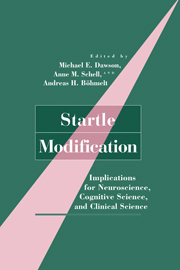Book contents
- Frontmatter
- Contents
- Contributors
- Preface
- Prologue: A Historical Note on the “Discovery” of Startle Modification
- 1 Startle Modification: Introduction and Overview
- PART I BASIC PARADIGMS, METHODS, AND PHENOMENA
- 2 Startle Elicitation: Stimulus Parameters, Recording Techniques, and Quantification
- 3 Short Lead Interval Startle Modification
- 4 Long Lead Interval Startle Modification
- PART II PHYSIOLOGICAL MEDIATION OF STARTLE MODIFICATION
- PART III PSYCHOLOGICAL MEDIATION OF STARTLE MODIFICATION
- PART IV INDIVIDUAL DIFFERENCES AND STARTLE MODIFICATION
- PART V RELATIONSHIPS WITH OTHER PARADIGMS AND MEASURES
- References
- Author Index
- Subject Index
2 - Startle Elicitation: Stimulus Parameters, Recording Techniques, and Quantification
Published online by Cambridge University Press: 26 March 2010
- Frontmatter
- Contents
- Contributors
- Preface
- Prologue: A Historical Note on the “Discovery” of Startle Modification
- 1 Startle Modification: Introduction and Overview
- PART I BASIC PARADIGMS, METHODS, AND PHENOMENA
- 2 Startle Elicitation: Stimulus Parameters, Recording Techniques, and Quantification
- 3 Short Lead Interval Startle Modification
- 4 Long Lead Interval Startle Modification
- PART II PHYSIOLOGICAL MEDIATION OF STARTLE MODIFICATION
- PART III PSYCHOLOGICAL MEDIATION OF STARTLE MODIFICATION
- PART IV INDIVIDUAL DIFFERENCES AND STARTLE MODIFICATION
- PART V RELATIONSHIPS WITH OTHER PARADIGMS AND MEASURES
- References
- Author Index
- Subject Index
Summary
ABSTRACT
This chapter reviews methods for eliciting, measuring, and quantifying the blink component of the startle response in humans. We begin with a brief summary of what is known about the physiological circuitry of the human startle blink. We discuss laboratory techniques for eliciting the startle blink with probe stimuli in auditory, cutaneous, or visual modalities. In a discussion of recording the human blink reflex, we focus on electromyographic (EMG) recording but consider other methods. We then address approaches for quantification of blink latency and amplitude, and also raise methodological questions that warrant further experimental investigation. This overview provides an introduction for researchers who are interested in learning how to measure startle. Issues relevant to startle modification techniques are also discussed.
Overview of Methodological Issues
In this chapter, we discuss methodological issues relevant to eliciting, recording, and quantifying the blink component of startle. This review is intended for new investigators because it provides a guide to methodological issues, as well as for experienced investigators, in the hope that this attempt to synthesize methodological concerns will stimulate discussion. Some aspects of startle methodology have been presented at meetings (Cook & Berg, 1995), in methodological abstracts (Balaban, Losito, Simons, & Graham, 1986a), and papers (Clarkson & Berg, 1984; Blumenthal, 1994).
There are three general topics to be addressed: How is the startle blink elicited, recorded, and quantified? We discuss startle elicited in auditory, cutaneous, and visual modalities. In the section on recording, we focus on electromyography (EMG) but briefly consider other methods. Aspects of signal processing are also addressed in this section.
- Type
- Chapter
- Information
- Startle ModificationImplications for Neuroscience, Cognitive Science, and Clinical Science, pp. 21 - 50Publisher: Cambridge University PressPrint publication year: 1999
- 43
- Cited by



